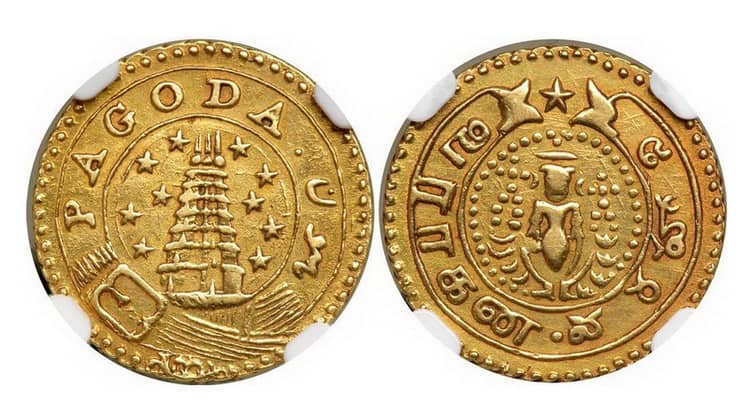
1 Indian pagoda is an ancient coin of gold, minted for the first time during the Mughal rule. It received its name due to the fact that the image of a cult Buddhist structure was present on the reverse. It was produced for a long time − until the XIX century. For collectors, this series is interesting by the variety of plots and high quality of coinage.
History
The first gold coins in India began to be minted during the Mughal rule. In the north and in the central part of the country, the currency was formed with a denomination of 1 Indian mohur. In the southern part of Farid Sher Shah (a Muslim warlord of Pashtun origin), 1 Indian pagoda appeared. Initially, both coins had almost the same weight (11 grams), but after the reform, the mass of the pagoda was 3.37 g of gold.
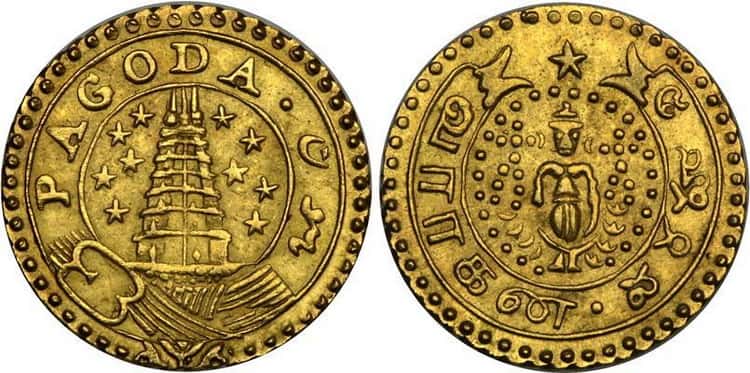
1 pagoda was used as a currency − with the help of a precious metal coin they supported domestic and foreign trade. The economy of this region is directly dependent on monetary support. In the period from 1539 to 1545, India was a multitude of flourishing small kingdoms, trading among themselves and neighboring states. A small gold coin of the same weight successfully replaced ingots and eliminated the need to weigh the precious metal during the transaction.
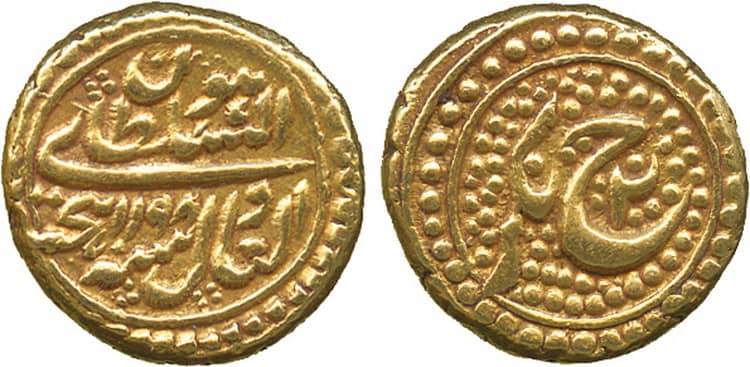
Despite the fact that Muslim culture forbade the image of living beings, the surface of the gold coin was decorated not only with Arabic script or classical symbols. This is due to the fact that the culture of the southern territory of India was influenced by the reforms of Akbar the Great. He implemented one of the main ideas of that period − created a centralized state with fair and equal treatment of all the populating peoples. Under him, the free worship of all religions and the minting of images on the surface of gold coins became available in all regions of the country.
Did you know? Akbar the Great attracted 1 pagodas of calligraphers and stamp makers to stamping. Experts believe that during his rule at least 10,000 stamps were created, but only a small part was used to produce the coin.
In 1765, the colonialists began to issue money in India. The change of the standard did not happen, since it was decided to leave the coins of gold with the same denomination and the same weight. In the southern part of the country, 1 Indian pagoda was used for trade exchange, and from 1 to 10 Indian rupees (mohurs) were used in the central and northern parts of the country. Coins minted until the beginning of XX century. With the transition to the silver standard, the rupee completely supplanted the pagodas.
1 pagoda in the regions of India ceased to be released in different years:
- 1809 in Bombay
- 1815 in Madras
- 1877 in Travancore
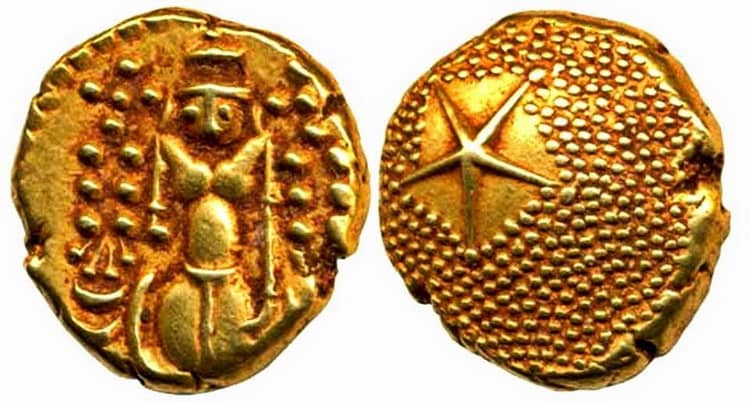
For the longest time only 1 pagoda of gold was produced in the city of Tranquebar. The Danish East India Company has turned the coast of this region into a center of trade and navigation between Denmark and India. On the reverse of the coin, the portrait of King Christian VI was minted, and on the obverse, the image of Goddess Lakshmi. One of the well-preserved copies was sold in November 2014 for 20,000 $ USD.
Did you know? There are three types of gold coins 1 pagoda, which were developed by foreign colonizers. The first and most valuable is the pagoda with a star (Star pagoda). It was minted in Madras from 1740 to 1804. The weight of the coin was 3.44 grams, diameter − 11.29 mm. There was a star on the reverse, and grains around it. On the obverse there is Vishnu. The cost of the coin today is about 15,000 $ USD. 25% cheaper is priced at 1 pagoda, released in Porto-Novo − by the Nawabs in the Akron settlement and by the Dutch in Tuticorin. Lower price at the pagoda of the French colonialists.
Design
1 Indian pagoda has an interesting and original design. The first samples contained an image of a pagoda (cult Buddhist structure) on the reverse. A few centuries later (under Akbar the Great − 1556-1601), images of animals − a tiger, a boar, a lion, an elephant and fish — were minted on the coin. The ruler strongly supported the development of culture and art in the territory of India, which belonged to the Mogul. The end of his reign is considered the peak of the development of Indian culture and art, including the production of coins.
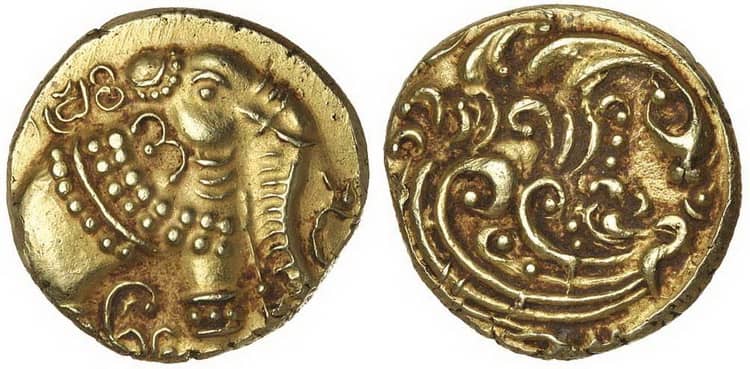
Until the XVII century on the 1st pagoda of gold depicted Hindu deities. The series is especially interesting to collectors, since in India there is an abundance of deities, which means that there is an opportunity to create a sufficiently large and informative collection. The most common coin of this period is 1 pagoda with minted Vishnu (the supreme deity in Vaishnavism). Later, samples depicting the Hindu goddess Lakshmi became more popular.
Did you know? 1 Vishnu pagoda has two types of obverse. In the first version of the coin has a picture of the Indian deity in the center. The other pagoda is decorated with three figures: in the center is Vishnu, and on the sides it is surrounded by his two spouses − Sridevi and Budevi.
During the rule of the emperor of the Baburid Empire, Muhammad Shah (1719-1748), the name of the ruler, the year of release (on the obverse) and the name of the Mint (on the reverse) were minted along with the image.
The Mysore golden pagoda received particular fame. It belongs to the 100 most expensive and rare coins of the world (a perfectly preserved specimen was sold for 13,000 dollars). The first specimen of precious metal was minted in 1788 in Madras (city of Seringapatam) under the ruler Sultan Tipu (1782-1799). The southern part of India is known for having its own alphabet on its territory and its own copy of a golden pagoda with Arabic script, dedicated to the Prophet Mohammed. Mysore deserved his fame thanks to a 40-year war against the colonialists.
Did you know? Many Indian communities held significant gold reserves. The government and the people of the country kept coins of precious metals, bullion and jewelry. For this reason, Mysore was a “tasty morsel” for the colonialists, but only from the fourth attempt did they manage to consolidate their power in this territory. The first two wars were lost, and the last two led to victory.
Circulation
Ancient coins of India, including the 1 pagoda coin, were issued for free circulation on a par with regular coinage currency units. For this reason, few people can even determine their approximate number. Even after the coin was ousted by the rupee, its production continued in several Indian principalities. It is known that the first editions were 1,064,000 samples, and the last about 26,000 units.
Cost of coins
The low price of 1 pagoda and a wide variety of images make coins attractive for collectors. The cost of individual samples is determined by several important factors:
- degree of preservation
- stamping period
- rarity
- demand
Did you know? Dutch 1 pagoda with a star is constantly growing in price. In 1777, for 1 coin they were ready to give 30.5 fans (the Indian monetary unit weighing 0.3-0.4 grams). In 1796, it was changed to 45 fans. Between 1802 and 1813, the star pagoda rose in price from 48 to 80 fans.
The cost of rare samples of good quality varies from 10,000 to 13,000 $ USD. If the quality is low or the circulation was large enough, the price does not exceed 1,000 $ USD.
Comments
No commens yet.